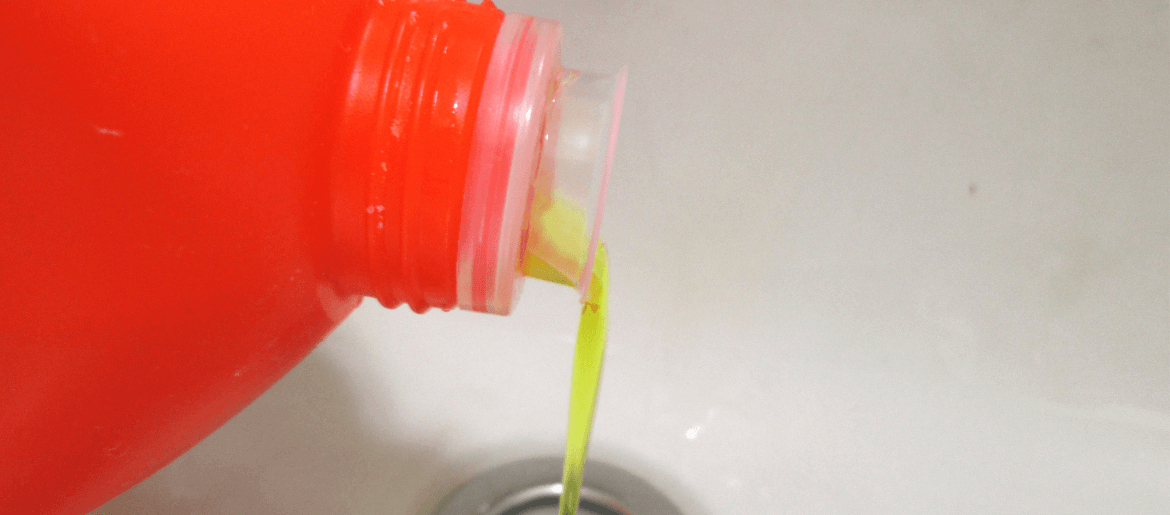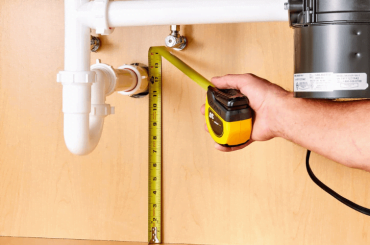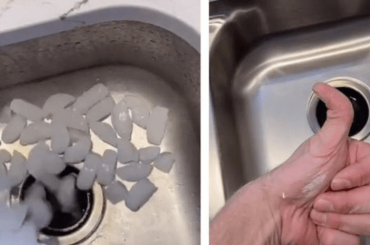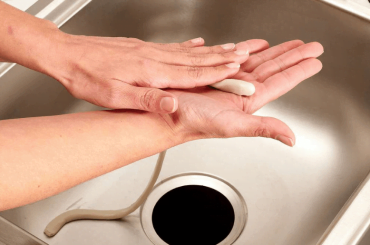Liquid fire drain cleaner is perfect for unclogging stubborn drains, but it can also be used in the toilet to keep it clean and free of clogs.
In this blog post, we’ll show you how to use liquid fire drain cleaner in the toilet so you can keep your plumbing running smoothly. We’ll also take a look at how to use liquid fire in standing water.
Keep reading for more tips on using liquid fire drain cleaner!
What is liquid fire drain cleaner and how does it work?
Liquid fire drain cleaners are chemical drain cleaners that use acid or alkaline chemicals to break up clogs formed by grease, hair and other organic wastes. These products can be used in most household drains, helping you keep your plumbing system running smoothly and efficiently.
Liquid fire drain cleaner is a powerful tool that can quickly and effectively unclog drains. It uses an active ingredient called sodium hydroxide to break down the grease, grime and other debris in your pipes. This chemical reaction generates heat which helps to dissolve the clog and clear the drain. When used properly, liquid fire will help remove clogs, clear blockages and freshen up your pipes. It is important to read the instructions on the package before using a liquid fire drain cleaner.
When used correctly, it can be a very effective tool for clearing stubborn clogs. However, if used incorrectly or in excess it can cause damage to fixtures and pipes so caution should be taken.
How to use liquid fire drain cleaner in toilet?
- Start by turning off the water supply to the toilet. This is done by either turning off the main water valve or shutting off the supply line behind your toilet.
- Put on rubber gloves, safety glasses and a face mask to protect yourself from any splashes or fumes that may arise during the cleaning process.
- Pour the liquid fire-drain cleaner into your toilet, according to the instructions on the label.
- Let it sit for about 30 minutes, then flush it with cold water and let it stand for another 10 minutes.
- Flush the toilet again with hot water to get rid of any residue left behind from the cleaner.
- Turn the water supply back on and use the toilet as normal.
- Clean and disinfect the area around the bowl with a bleach solution to make sure all bacteria are killed and all germs are gone.
- If necessary, pour additional cleaner down your drain so that it can clear any clogs in your pipes as well.
- If a clog persists after using a liquid fire drain cleaner, contact a plumber for assistance. Make sure to store the remaining liquid fire drain cleaner out of reach of children and pets.
Also Read: How To Remove Water Calcium Buildup/Deposits?
Benefits of using liquid fire drain cleaner in the toilet
Using liquid fire drain cleaner in the toilet can offer several benefits such as
- Unblocking of drains: Liquid Fire Drain Cleaner is specially formulated to dissolve organic matter like grease, hair and soap scum that accumulates in your toilet pipes over time. This will help unclog blocked toilets quickly and efficiently.
- Prevention of future blockages: By regularly cleaning your toilet with a Liquid Fire Drain Cleaner, you can help prevent future blockages from occurring. The active ingredients in the cleaner will break down organic matter that could eventually clog your drains and cause plumbing problems.
- Elimination of unpleasant odors: Regular use of Liquid Fire Drain Cleaner will help eliminate unpleasant odors caused by accumulated organic matter in your toilet pipes. The cleaner has a pleasant citrus scent that can freshen up any bathroom.
- Safety: Liquid Fire Drain Cleaner is non-toxic and biodegradable, making it safer to use than some other chemical-based drain cleaners. This means it won’t harm you or your family or the environment.
- Cost-effective: Using Liquid Fire Drain Cleaner in your toilet is a cost-effective way to keep it clean and running smoothly. It’s much cheaper than calling a plumber and you can buy it in large quantities if needed.
How to clean a clogged toilet with liquid fire drain cleaner?
- The first step to unclogging a toilet with a liquid fire drain cleaner is to identify the location of the blockage. If it is in the tramway, then you need to turn off the water supply and flush the toilet several times until all of the water has drained out. Then, pour about 1/2 cup of Liquid Fire drain cleaner into the toilet bowl.
- Then wait for about 15 minutes so that the drain cleaner can dissolve and break up any clogs or blockages in the tramway.
- After this, flush the toilet several times to ensure that any remaining pieces of debris are flushed down properly.
- Use a plunger to help remove any remaining pieces of debris that may have been trapped in the tramway. Move the plunger up and down, as if pushing against an imaginary blockage. After a few pushes, check the toilet to see if any more clogs or blockages are present.
- The last step is to use a drain snake to remove any remaining clogs from the tramway. Insert the snake into the toilet and push it up and down until it reaches any blockages that may have been left behind.
- If you still encounter resistance, use a pair of pliers to break up any remaining debris before flushing the toilet one final time. Once these steps are complete, your toilet should be unclogged and ready to use.
Can you use liquid fire in standing water?
No, it is not safe to use liquid fire in standing water. Liquid fire is highly combustible and can easily lead to a dangerous fire if used improperly. It should only be used outdoors in an area clear of any flammable materials and the area should be monitored closely while using liquid fire.
Additionally, it should never be used near standing water, as it may cause dangerous flare-ups and potentially ignite the water. If you need to use liquid fire in or near a standing body of water, you should contact a professional for advice.
The safest method of using liquid fire is to create a trench around your outdoor area and fill it with sand. This will help contain the flames and limit the risk of a dangerous flare-up. Additionally, it is important to keep an eye on the fire at all times and never leave it unattended.
How to use liquid fire in standing water?
- To use liquid fire in standing water, first, make sure that the area is well-ventilated and that all safety precautions are taken.
- Then use eye protection when handling the liquid fire and be sure to keep it away from any open flames.
- Next, pour a small amount of the liquid fire into a container with standing water. Use enough to create a reaction but not enough to cause an overflow.
- Then move away from the container and wait for the reaction to occur. The liquid fire will create a large flame which should be extinguished as quickly as possible with a fire extinguisher or water.
- After the flame has been extinguished, dispose of any remaining liquid fire properly by local regulations. Be sure to take all necessary safety precautions when handling liquid fire.
Follow these steps carefully and you should be able to safely use liquid fire in standing water.
Benefits of using liquid fire in standing water
- Using liquid fire in standing water can be very beneficial. It helps to create a barrier between the water and the surface, preventing further damage from occurring.
- The fire also acts as a disinfectant, killing any bacteria that may be present.
- Liquid fire is also an effective way to help keep fires contained, as it helps to prevent them from spreading to other areas.
- Furthermore, it can help to clear away smoke and fumes that may be present in standing water.
- Lastly, using liquid fire can help to reduce the amount of silt, dirt and debris that collects on the surface of standing water. This helps to maintain a clean and safe environment for anyone who uses the area.
- All in all, using liquid fire in standing water can help to keep the area clean and safe while protecting it from further damage.
FAQs – Liquid Fire Drain Cleaner Uses
What happens if you put drain cleaner in the toilet?
Putting drain cleaner in the toilet can be extremely dangerous. Drain cleaners contain harsh chemicals that are meant to break down organic materials, such as hair and grease. When these chemicals come into contact with human skin or eyes, they can cause severe irritation and burns.
Additionally, when flushed down a toilet, the harsh chemicals could damage pipes and septic systems. In short, it is highly recommended to avoid putting drain cleaner in the toilet at all costs.
What is the best liquid drain cleaner for the toilet?
The best liquid drain cleaner for the toilet is likely to depend on the type of clog you are dealing with.
For general maintenance and prevention of slow-running drains, a mild, non-corrosive drain cleaner such as one containing sodium hydroxide is ideal. If the clog is caused by grease or soap buildup, a blend of enzymes is likely the best option.
For more stubborn clogs, a sulfuric acid-based cleaner may be needed. Be sure to read and follow all instructions on the product label before using any drain cleaning product.
What dissolves toilet blockage?
To dissolve a toilet blockage, you can use a drain snake to help break up the clog. Other household items such as vinegar and baking soda, hot water and dish soap can be poured into the bowl to loosen the clog.
If these methods fail to clear the clog, you may need to use a commercial chemical that is designed to break down the blockage. Be sure to follow all safety instructions when using these chemicals and never use them in excess.
Finally, if all else fails you may need to call a plumber for assistance.
Final Words
It is very easy. The first step is to remove the lid of the tank. Once that is done, pour the entire bottle of liquid fire into the hole on the side of the tank.
Be sure to close the lid quickly so that you don’t get burned. Finally, flush the toilet and watch as your drains are cleared in a matter of minutes!
We hope this article was helpful and that you will now be able to unclog your drains with ease. Have any questions? Let us know in the comment section below!





